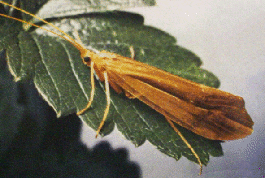
Consulting Entomologist

Tel/Fax: 01275 854224
E-Mail: [email protected]
Site Guide
Site Search
Home Page
Career Page
Insect Files
- Contents
- Bug Index
- The World of Bugs
- Classification of Bugs
- Insect Identification
- Insect Fossils
- Insect Body-parts
- Micro View of Bugs
- Insect Life Cycles
- Insect Defences
- Insects of Nailsea
- Pesticide Safety
- Bibliography
Shortcut to the main groups of insects and other arthropods...
Bug Rhymes & Poems
Links
Shop
Payments (credit/debit card)
Order Trichoptera - Caddis Flies(Tricho-ptera, from Greek trichos = hair, pteron = wing) |
Class: Insecta Order: Trichoptera | |
| Examples: | ||
|
Moth-like insects, with two pairs of membranous wings densely covered with tiny hairs and held roof-wise over the body at rest. All are fairly weak flyers and the females of a few species are wingless. Most are dull brownish or greyish insects, flying at dusk. Antennae very long and thread-like. Simple biting mouthparts, but these are poorly developed and often vestigial. The adults of some species feed on nectar, but most probably do not feed. Normally found near water. There is a complex metamorphosis, usually with five larval stages and a pupal stage. The young stages are nearly always aquatic, living in freshwater ponds, lakes, streams and rivers. Most caddis larvae surround themselves with a protective case, made from various materials from their surroundings fastened together with a sticky silk-like secretion produced from a gland near the mouth. Each species uses its own particular materials - grains of sand, plant fragments and even empty snail shells - and builds its case to a specific design. It is often possible to identify a species simply from its case. The sand grains or other materials are frequently cemented together very neatly to form a mosaic. As the larva grows, it adds material to the front of the case. Case-bearing larvae have two strong hooks at the tip of the abdomen, which grip the silken lining of the case and ensure that the caddis and its home do not part company. Not all caddis larvae make cases - several species live in fixed silken nets which they spin among aquatic vegetation, and a few are free-living with neither cases nor nets. Larvae have strong biting mouthparts. Most of the case-bearing and net-living forms are omnivorous, feeding on any scraps of plant or animal matter they can find, but the free-living species are largely predatory. Caddis Flies are closely related to the Lepidoptera (Butterflies and Moths) and structurally very similar to certain moths. Smaller members of the two groups are easily confused, but the hairy (not scaled) wings and the lack of a coiled proboscis will distinguish the Caddis Flies. The Order contains nearly 6,000 species, of which about 190 are represented in the British Isles. |
|
(classification of insects) |
(identification key to insect orders) |
| <<< TOP | (use the back button on your web browser to return to the previous page) | TOP >>> |
